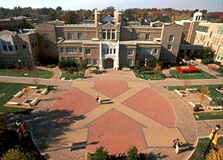Spring Meeting
MAA Ohio Section
April 5-6, 2002
Xavier University.
(History link.)
 Xavier University was established in 1831 when the first Catholic bishop of
Cincinnati, Edward Fenwick, raised a two-story building near the cathedral
in downtown Cincinnati and opened its doors to educate seminarians and
other young men in the Ohio area. This institute of arts and sciences, the
first Catholic institution of higher learning in the Northwest Territory,
was originally named The Athanaeum, but it was dedicated from the beginning
to the patronage of St. Francis Xavier.
Xavier University was established in 1831 when the first Catholic bishop of
Cincinnati, Edward Fenwick, raised a two-story building near the cathedral
in downtown Cincinnati and opened its doors to educate seminarians and
other young men in the Ohio area. This institute of arts and sciences, the
first Catholic institution of higher learning in the Northwest Territory,
was originally named The Athanaeum, but it was dedicated from the beginning
to the patronage of St. Francis Xavier.
In 1840, Fenwick's successor, Bishop John Baptist Purcell, handed over the
administration of the college to the Society of Jesus (the order of Jesuit
priests), who renamed the school St. Xavier College. At the same time,
they added a mercantile program to the curriculum, recognizing the need to
supplement the traditional humanities education with a sound education in
business practices. They also offered night courses as early as 1841 to
serve the needs and schedules of professionals in the Cincinnati community.
The college moved to its present location in the geographic center of
Cincinnati in 1919 when its growth called for new and larger facilities,
and its name was changed to Xavier University in 1930. In 1970, Xavier
went coeducational, and in 1980, it acquired a neighboring women's liberal
arts college, Edgecliff College, and brought Edgecliff programs to the
Xavier campus. Also in the 1980s and 1990s, Xavier benefited from the
donations of a number of contiguous properties, allowing the university to
build student housing and erect other buildings to hold its expanding
programs, including most notably the opening in 2000 of the
Cintas Center,
a state-of-the-art facility housing dining services, a sports arena, and a
convention center.
Today, Xavier University is one of 28 Jesuit colleges and universities in
the U.S. (along with its sister institution in Ohio, John Carroll
University). It enrolls 6700 students, including 4000 undergraduates. The
majority of its post-graduate students are involved in its well-respected
MBA program, or in masters programs in education. Its undergraduate
programs share a commitment to the liberal arts with emphasis on the
ethical and religious analysis of socially significant issues; roughly 60%
of every studentís coursework is part of a common core curriculum.
The Department of Mathematics and Computer Science
serves some 40
undergraduate majors in mathematics and almost 60 undergraduate computer
science majors with a faculty of 15 members, including three computer
scientists and two academic staff (full-time instructors). Since every
undergraduate at Xavier typically takes two mathematics courses as a
component of their liberal arts core curriculum, a large number of courses
are taught to non-majors. Recently, some innovative course offerings have
been Women in Mathematics, Calculus from an Historical Perspective, and
Complexity and the Origin of Order. Some distinctive elements of the
mathematics major program are: weekly Maple lab experiences in the
three-course calculus sequence; a discrete mathematics course in the
freshman year; a year-long linear algebra course in the sophomore year; and
a senior research project under the direction of a faculty member that
culminates in a paper and presentation before the entire department. Math
majors staff the universityís Math Tutoring Lab and participate in an
active MAA Student Chapter. The Ohio Theta Chapter of Pi Mu Epsilon has
been inducting members annually since 1962.
Danny Otero
Return to meeting page.
 Return to the Ohio Section Home Page
Return to the Ohio Section Home Page
Maintained by the
Department of
Mathematics and Statistics, Bowling Green State University,
Bowling Green, Ohio 43403-0221. Address comments and suggestions
to hern@wcnet.org.
 Xavier University was established in 1831 when the first Catholic bishop of
Cincinnati, Edward Fenwick, raised a two-story building near the cathedral
in downtown Cincinnati and opened its doors to educate seminarians and
other young men in the Ohio area. This institute of arts and sciences, the
first Catholic institution of higher learning in the Northwest Territory,
was originally named The Athanaeum, but it was dedicated from the beginning
to the patronage of St. Francis Xavier.
Xavier University was established in 1831 when the first Catholic bishop of
Cincinnati, Edward Fenwick, raised a two-story building near the cathedral
in downtown Cincinnati and opened its doors to educate seminarians and
other young men in the Ohio area. This institute of arts and sciences, the
first Catholic institution of higher learning in the Northwest Territory,
was originally named The Athanaeum, but it was dedicated from the beginning
to the patronage of St. Francis Xavier.
